這篇文章主要介紹了mysql查詢表里的重復(fù)數(shù)據(jù)方法,需要的朋友可以參考下
INSERT?INTO?hk_test(username,?passwd)?VALUES ('qmf1',?'qmf1'),('qmf2',?'qmf11') ? delete?from?hk_test?where?username='qmf1'?and?passwd='qmf1'
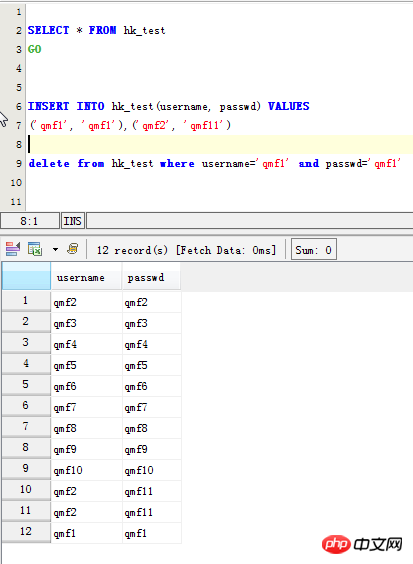
MySQL里查詢表里的重復(fù)數(shù)據(jù)記錄:
先查看重復(fù)的原始數(shù)據(jù):
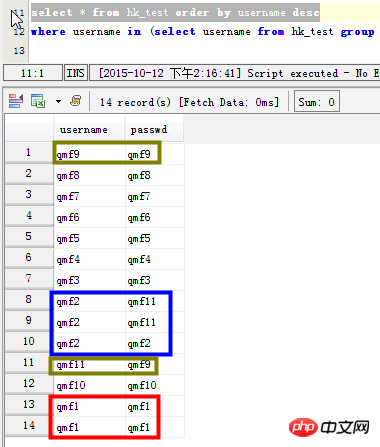
場(chǎng)景一:列出username字段有重讀的數(shù)據(jù)
select?username,count(*)?as?count?from?hk_test?group?by?username?having?count>1; ? SELECT?username,count(username)?as?count?FROM?hk_test?GROUP?BY?username?HAVING?count(username)?>1?ORDER?BY?count?DESC;
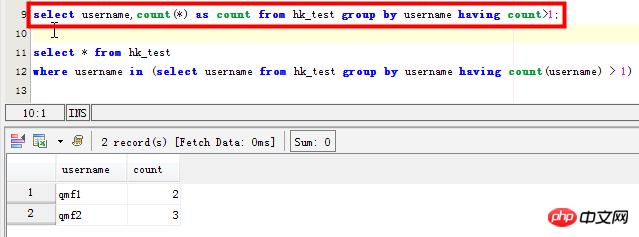
這種方法只是統(tǒng)計(jì)了該字段重復(fù)對(duì)應(yīng)的具體的個(gè)數(shù)
場(chǎng)景二:列出username字段重復(fù)記錄的具體指:
select?*?from?hk_test?where?username?in?(select?username?from?hk_test?group?by?username?having?count(username)?>?1) ? SELECT?username,passwd?FROM?hk_test?WHERE?username?in?(?SELECT?username?FROM?hk_test?GROUP?BY?username?HAVING?count(username)>1) ? 但是這條語句在mysql中效率太差,感覺mysql并沒有為子查詢生成臨時(shí)表。在數(shù)據(jù)量大的時(shí)候,耗時(shí)很長(zhǎng)時(shí)間

解決方法:
于是使用先建立臨時(shí)表? ? create?table?`tmptable`?as?(? SELECT?`name`? FROM?`table`? GROUP?BY?`name`?HAVING?count(`name`)?>1? );? ? 然后使用多表連接查詢 ? SELECT?a.`id`,?a.`name`? FROM?`table`?a,?`tmptable`?t? WHERE?a.`name`?=?t.`name`;? ? 結(jié)果這次結(jié)果很快就出來了。 ? 用?distinct去重復(fù) ? SELECT?distinct?a.`id`,?a.`name`? FROM?`table`?a,?`tmptable`?t? WHERE?a.`name`?=?t.`name`;
場(chǎng)景三:查看兩個(gè)字段都重復(fù)的記錄:比如username和passwd兩個(gè)字段都有重復(fù)的記錄:
select?*?from?hk_test?a where?(a.username,a.passwd)?in?(select?username,passwd?from?hk_test?group?by?username,passwd?having?count(*)?>?1)

場(chǎng)景四:查詢表中多個(gè)字段同時(shí)重復(fù)的記錄:
select?username,passwd,count(*)?from?hk_test?group?by?username,passwd?having?count(*)?>?1

MySQL查詢表內(nèi)重復(fù)記錄 ? 查詢及刪除重復(fù)記錄的方法 (一) 1、查找表中多余的重復(fù)記錄,重復(fù)記錄是根據(jù)單個(gè)字段(peopleId)來判斷 select?*? from?people where?peopleId?in?(select?peopleId?from?people?group?by?peopleId?having?count(peopleId)>1) ? 2、刪除表中多余的重復(fù)記錄,重復(fù)記錄是根據(jù)單個(gè)字段(peopleId)來判斷,只留有一個(gè)記錄 delete?from?people where?peopleId?in?(select?peopleId? from?people?group?by?peopleId?having?count(peopleId)>1) and?min(id)?not? in?(select?id?from?people?group?by?peopleId?having?count(peopleId)>1) ? 3、查找表中多余的重復(fù)記錄(多個(gè)字段) select?*?from?vitae?a where?(a.peopleId,a.seq)?in? (select?peopleId,seq?from?vitae?group?by?peopleId,seq?having?count(*)>1) ? 4、刪除表中多余的重復(fù)記錄(多個(gè)字段),只留有rowid最小的記錄 delete?from?vitae?a where? (a.peopleId,a.seq)?in?(select?peopleId,seq?from?vitae?group?by?peopleId,seq? having?count(*)?>?1) and?rowid?not?in?(select?min(rowid)?from?vitae?group? by?peopleId,seq?having?count(*)>1) ? 5、查找表中多余的重復(fù)記錄(多個(gè)字段),不包含rowid最小的記錄 select?*?from?vitae?a where? (a.peopleId,a.seq)?in?(select?peopleId,seq?from?vitae?group?by?peopleId,seq? having?count(*)?>?1) and?rowid?not?in?(select?min(rowid)?from?vitae?group? by?peopleId,seq?having?count(*)>1) ? (二) 比方說 在A表中存在一個(gè)字段“name”,而且不同記錄之間的“name”值有可能會(huì)相同,現(xiàn)在就是需要查詢出在該表中的各記錄之間,“name”值存在重復(fù)的項(xiàng); Select?Name,Count(*)?From?A?Group?By?Name?Having?Count(*)?>?1 如果還查性別也相同大則如下: Select?Name,sex,Count(*)?From?A?Group?By?Name,sex?Having?Count(*)?>?1 ? (三) 方法一 declare?@max?integer,@id?integer declare?cur_rows?cursor?local?for?select?主字段,count(*)?from?表名?group?by?主字段? having?count(*)?>;?1 open?cur_rows fetch?cur_rows?into?@id,@max while?@@fetch_status=0 begin select?@max?=?@max?-1 set?rowcount?@max delete?from?表名?where?主字段?=?@id fetch?cur_rows?into?@id,@max end close?cur_rows set?rowcount?0
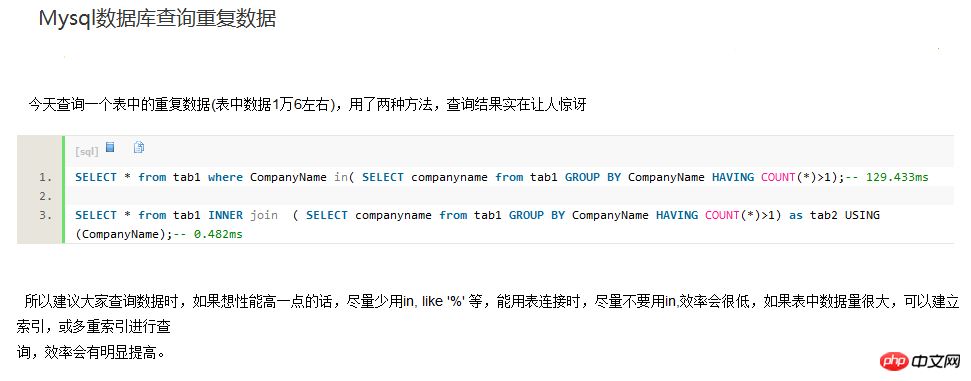
SELECT?*?from?tab1?where?CompanyName?in(?SELECT?companyname?from?tab1?GROUP?BY?CompanyName?HAVING?COUNT(*)>1); --?129.433ms? ? SELECT?*?from?tab1?INNER?join?(?SELECT?companyname?from?tab1?GROUP?BY?CompanyName?HAVING?COUNT(*)>1)?as?tab2?USING(CompanyName); --?0.482ms ? 方法二 ? 有兩個(gè)意義上的重復(fù)記錄,一是完全重復(fù)的記錄,也即所有字段均重復(fù)的記錄,二是部分關(guān)鍵字段重復(fù)的記錄,比如Name字段重復(fù),而其他字段不一定重復(fù)或都重復(fù)可以忽略。 ? 1、對(duì)于第一種重復(fù),比較容易解決,使用 ? select?distinct?*?from?tableName ? 就可以得到無重復(fù)記錄的結(jié)果集。 ? 如果該表需要?jiǎng)h除重復(fù)的記錄(重復(fù)記錄保留1條),可以按以下方法刪除 ? select?distinct?*?into?#Tmp?from?tableName ? drop?table?tableName ? select?*?into?tableName?from?#Tmp ? drop?table?#Tmp ? 發(fā)生這種重復(fù)的原因是表設(shè)計(jì)不周產(chǎn)生的,增加唯一索引列即可解決。 ? 2、這類重復(fù)問題通常要求保留重復(fù)記錄中的第一條記錄,操作方法如下 ? 假設(shè)有重復(fù)的字段為Name,Address,要求得到這兩個(gè)字段唯一的結(jié)果集 ? select?identity(int,1,1)?as?autoID,?*?into?#Tmp?from?tableName ? select?min(autoID)?as?autoID?into?#Tmp2?from?#Tmp?group?by?Name,autoID ? select?*?from?#Tmp?where?autoID?in(select?autoID?from?#tmp2) ? 最后一個(gè)select即得到了Name,Address不重復(fù)的結(jié)果集(但多了一個(gè)autoID字段,實(shí)際寫時(shí)可以寫在select子句中省去此列) ? (四)查詢重復(fù) ? select?*?from?tablename?where?id?in?( ? select?id?from?tablename?group?by?id?having?count(id)?>?1) 常用的語句 ? 1、查找表中多余的重復(fù)記錄,重復(fù)記錄是根據(jù)單個(gè)字段(mail_id)來判斷 ? ?代碼如下?復(fù)制代碼? ?SELECT?*?FROM?table?WHERE?mail_id?IN?(SELECT?mail_id?FROM?table?GROUP?BY?mail_id?HAVING?COUNT(mail_id)?>?1); ? ? 2、刪除表中多余的重復(fù)記錄,重復(fù)記錄是根據(jù)單個(gè)字段(mail_id)來判斷,只留有rowid最小的記錄 ? ?代碼如下?復(fù)制代碼? DELETE?FROM?table?WHERE?mail_id?IN?(SELECT?mail_id?FROM?table?GROUP?BY?mail_id?HAVING?COUNT(mail_id)?>?1)?AND?rowid?NOT?IN?(SELECT?MIN(rowid)?FROM?table?GROUP?BY?mail_id?HAVING?COUNT(mail_id?)>1); ? ? 3、查找表中多余的重復(fù)記錄(多個(gè)字段) ? ?代碼如下?復(fù)制代碼? SELECT?*?FROM?table?WHERE?(mail_id,phone)?IN?(SELECT?mail_id,phone?FROM?table?GROUP?BY?mail_id,phone?HAVING?COUNT(*)?>?1); ? ? 4、刪除表中多余的重復(fù)記錄(多個(gè)字段),只留有rowid最小的記錄 ? ?代碼如下?復(fù)制代碼? ?DELETE?FROM?table?WHERE?(mail_id,phone)?IN?(SELECT?mail_id,phone?FROM?table?GROUP?BY?mail_id,phone?HAVING?COU(www.jb51.net)NT(*)?>?1)?AND?rowid?NOT?IN?(SELECT?MIN(rowid)?FROM?table?GROUP?BY?mail_id,phone?HAVING?COUNT(*)>1); ? ? 5、查找表中多余的重復(fù)記錄(多個(gè)字段),不包含rowid最小的記錄 ? ?代碼如下?復(fù)制代碼? SELECT?*?FROM?table?WHERE?(a.mail_id,a.phone)?IN?(SELECT?mail_id,phone?FROM?table?GROUP?BY?mail_id,phone?HAVING?COUNT(*)?>?1)?AND?rowid?NOT?IN?(SELECT?MIN(rowid)?FROM?table?GROUP?BY?mail_id,phone?HAVING?COUNT(*)>1); ? ? 存儲(chǔ)過程 ? declare?@max?integer,@id?integer ? declare?cur_rows?cursor?local?for?select?主字段,count(*)?from?表名?group?by?主字段?having?count(*)?>;?1 ? open?cur_rows ? fetch?cur_rows?into?@id,@max ? while?@@fetch_status=0 ? begin ? select?@max?=?@max?-1 ? set?rowcount?@max ? delete?from?表名?where?主字段?=?@id ? fetch?cur_rows?into?@id,@max ? end ? close?cur_rows ? set?rowcount?0 ? ? ? (一)單個(gè)字段 ? 1、查找表中多余的重復(fù)記錄,根據(jù)(question_title)字段來判斷 ? ?代碼如下?復(fù)制代碼? select?*?from?questions?where?question_title?in?(select?question_title?from?people?group?by?question_title?having?count(question_title)?>?1) ? ? 2、刪除表中多余的重復(fù)記錄,根據(jù)(question_title)字段來判斷,只留有一個(gè)記錄 ? ?代碼如下?復(fù)制代碼? delete?from?questions where?peopleId?in?(select?peopleId?from?people?group?by?peopleId?having?count(question_title)?>?1) and?min(id)?not?in?(select?question_id?from?questions?group?by?question_title?having?count(question_title)>1)? ? (二)多個(gè)字段 ? 刪除表中多余的重復(fù)記錄(多個(gè)字段),只留有rowid最小的記錄 ? ?代碼如下?復(fù)制代碼? DELETE?FROM?questions?WHERE?(questions_title,questions_scope)?IN?(SELECT?questions_title,questions_scope?FROM?que(www.jb51.net)stions?GROUP?BY?questions_title,questions_scope?HAVING?COUNT(*)?>?1)?AND?question_id?NOT?IN?(SELECT?MIN(question_id)?FROM?questions?GROUP?BY?questions_scope,questions_title?HAVING?COUNT(*)>1) ? ? 用上述語句無法刪除,創(chuàng)建了臨時(shí)表才刪的,求各位達(dá)人解釋一下。 ? ?代碼如下?復(fù)制代碼? CREATE?TABLE?tmp?AS?SELECT?question_id?FROM?questions?WHERE?(questions_title,questions_scope)?IN?(SELECT?questions_title,questions_scope?FROM?questions?GROUP?BY?questions_title,questions_scope?HAVING?COUNT(*)?>?1)?AND?question_id?NOT?IN?(SELECT?MIN(question_id)?FROM?questions?GROUP?BY?questions_scope,questions_title?HAVING?COUNT(*)>1); ? DELETE?FROM?questions?WHERE?question_id?IN?(SELECT?question_id?FROM?tmp); ? DROP?TABLE?tmp;
查找mysql數(shù)據(jù)表中重復(fù)記錄
mysql數(shù)據(jù)庫中的數(shù)據(jù)越來越多,當(dāng)然排除不了重復(fù)的數(shù)據(jù),在維護(hù)數(shù)據(jù)的時(shí)候突然想到要把多余的數(shù)據(jù)給刪減掉,剩下有價(jià)值的數(shù)據(jù)。
以下sql語句可以實(shí)現(xiàn)查找出一個(gè)表中的所有重復(fù)的記錄.
select user_name,count(*) as count from user_table group by user_name having count>1;
參數(shù)說明:
user_name為要查找的重復(fù)字段.
count用來判斷大于一的才是重復(fù)的.
user_table為要查找的表名.
group by用來分組
having用來過濾.
把參數(shù)換成自己數(shù)據(jù)表的相應(yīng)字段參數(shù),可以先在Phpmyadmin里面或者Navicat里面去運(yùn)行,看看有哪些數(shù)據(jù)重復(fù)了,然后在數(shù)據(jù)庫里面刪除掉,也可以直接將SQL語句放到后臺(tái)讀取新聞的頁面里面讀取出來,完善成查詢重復(fù)數(shù)據(jù)的列表,有重復(fù)的可以直接刪除。
效果如下:
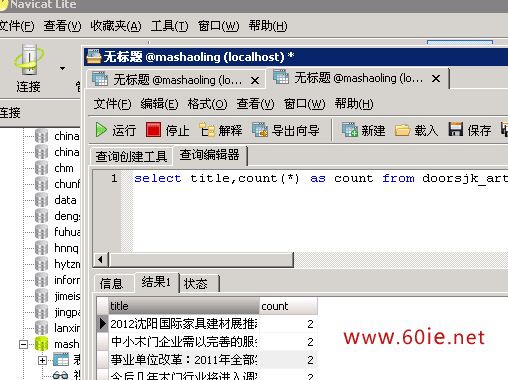
缺點(diǎn):這種方法的缺點(diǎn)就是當(dāng)你的數(shù)據(jù)庫里面的數(shù)據(jù)量很大的時(shí)候,效率很低,我用的是Navicat測(cè)試的,數(shù)據(jù)量不大,效率很高,當(dāng)然,網(wǎng)站還有其它查詢數(shù)據(jù)重復(fù)的SQL語句,舉一反三,大家好好研究研究,找到一個(gè)適合自己網(wǎng)站的查詢語句。
.jpg)









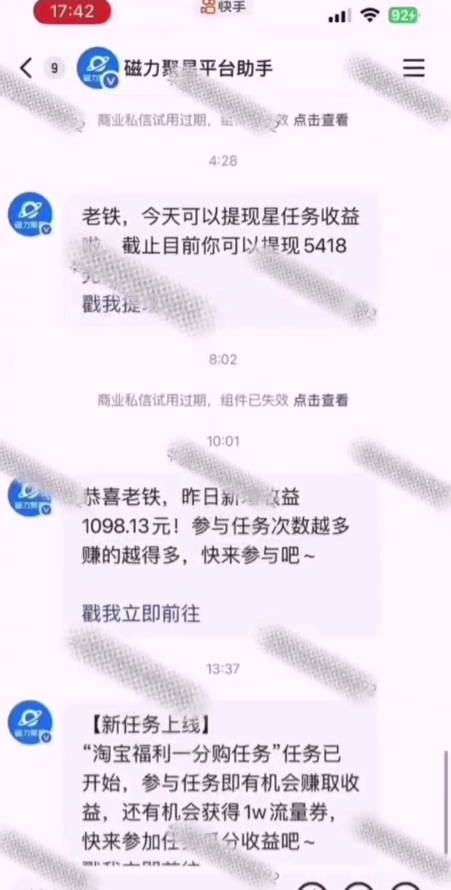

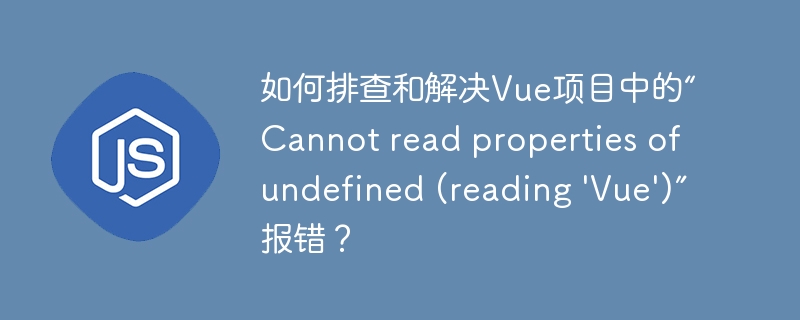





.png)
